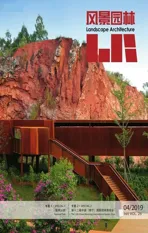国家公园与风景园林
2019-12-03赵智聪

2013年11月,中共十八届三中全会提出“建立国家公园体制”; 2015年5月,国家发展改革委会同13个部门出台《建立国家公园体制试点方案》,开始推进在中国9省市进行国家公园体制试点; 2017年9月,中共中央办公厅、国务院办公厅发布《建立国家公园体制总体方案》;2017年10月,党的十九大报告进一步提出“建立以国家公园为主体的自然保护地体系”的战略要求;2018年3月,国务院机构改革方案大举推进,组建国家林业和草原局,加挂国家公园管理局牌子,负责监督管理以国家公园为主体的各类自然保护地,各方翘首以盼的“由一个部门统一管理各种类型自然保护地”的局面初见端倪。
一系列围绕国家公园的战略布局、制度设计和改革措施,在短短几年的时间内出台、落地和推进,国家公园体制建设成为中国生态文明建设中推进最快的一项制度。同时,值得关注的是,建立国家公园体制是一项综合性的改革举措,理学、工学、农学、法学、经济学、历史学、管理学、教育学等学科门类均有涉及;从生态保护与修复等技术性问题到生态搬迁、精准扶贫等社会性问题,从政府治理到公众参与等机制性问题,社会政治经济生活的方方面面都已经纳入国家公园体制研究视野。
我们十分欣喜地看到,在这场变革中,风景园林学的学者正在发挥重要作用。世界范围来看,很少有哪个国家的风景园林师能如此全面而深入地参与国家公园建设,中国风景园林研究者和工作者的担当与勇气、洞见和积累无疑已经成为中国国家公园体制乃至生态文明建设中的掷地金声。
这不仅是因为在风景园林学科发展中,风景名胜区研究一直是学科的核心内容之一,风景名胜区是我们不断汲取中国传统文化精髓的宝藏,也让风景园林学科与自然保护地产生了天然的联系;还因为这场关乎中国生态安全、文化自信和人民福祉的改革,既需要有顶层设计的宏观策略,也需要有寻幽探微的审慎分析,风景园林人应有的思维广度与深度契合了历史的需要。更为重要的是,风景园林学科应该在各个尺度与层面,运用各种能力和手段解决生态环境问题,谋划人们美好生活和传承创新优秀文化,这需要高掌远跖的目标,需要脚踏实地的行动,国家公园体制建设之初心正在于此。
本期专题文章,既有全球尺度的高瞻远瞩,也有国家公园案例的析毫剖厘,既有技术层面的钩深索隐,也不乏政策解析的鞭辟入里。希望作者的殚精竭虑能引发更多读者的关注和兴趣,希望风景园林学能够在这个充满机遇与挑战的时代贡献更多智慧。
本期专题组稿人:赵智聪
2019年3月29日
PREFACE
Landscape Architecture and National Parks
The Third Plenary Session of the Eighteenth CPC Central Committee in November 2013 required “establishing the national park system”. In May 2015, the National Development and Reform Commission along with 13 ministerial departments issued the Pilot Program for Establishing National Park System to exercise the national park system in 9 provinces and municipalities. In September 2017, the General Office of the CPC Central Committee and the State Office of the State Council jointly issued the Overall Plan for Establishing National Park System. In October 2017, the report of the nineteenth CPC National Congress further put forward the strategic requirement of “establishing the protected area for nature system based on national parks”. In March 2018, the State Council conducted a major institutional reform to establish the State Forestry and Grassland Administration, additionally executing as the National Park Administration Agency, to supervise and manage all types of natural protected areas with the national parks as the main component, indicating the goal of “one ministerial department responsible for the unified administration of various types of protected areas” is expected to be realized soon.
The promulgation, execution and supervision of the serial strategic layouts, institutional design and reform measures centering around national parks have happened within just years makes the national park construction the most quickly executed administration system of the Chinese ecological civilization construction. In the meantime, it is worth noting that the establishment of national park system is a multi-discipline integral reform measure involving science, engineering, agronomy, law, economics, history, management and education etc. Diverse aspects ranging from technical issues of ecological conservation and restoration to social issues of ecological resettlement, targeted poverty alleviation, to governance mechanism of government administration and public participation, and to sociopolitical and socioeconomic life have been incorporated into the national park system research.
We are very pleased to witness the important role play of landscape architecture scholars in the above reform process. From the global perspective, landscape architects in few countries have managed to participate in the construction of national parks in such a comprehensive and in-depth manner. The accountability and courage, insight and accumulation of Chinese landscape architects,researchers and workers have undoubtedly uttered their “sound of gold” in course of the construction of Chinese national park system and ecological civilization.
It is so not only because the study of Scenic and Historical Areas has always been one core component of the discipline of landscape architecture in its development. They are both treasures that concentrate continuously the essence of Chinese traditional culture and natural linkages between the landscape architecture and protected areas. Moreover, this reform is related to China’s ecological security, cultural self-confidence and the people’s well-being, requiring both macro strategy from top-level design and prudent analytical exploration of micro details. The cognitional width and depth of landscape architects has coincided with the demand of history.More importantly, the landscape architecture discipline should utilize its diversified strengths and methods to solve the ecological and environmental problems existent at different dimensions and levels to scheming people’s well-being and promoting culture inheritance and innovation. This requires both courageous grand goals and down-to-earth actions and is the original intention of constructing the national park system.
This articles of this issue includes both far-sighted visions from global scale and delicate case studies of specific national parks, both intricate technical explorations and penetrating policy analysis. Hope these contributions deserve attention and interest from more readers,and also hope that landscape architecture can devote more wisdom in the era full of opportunities and challenges.
Translator: WANG Xiyue
Acquiring Editor of the current issue: Zhao Zhicong
March 29th, 2019
